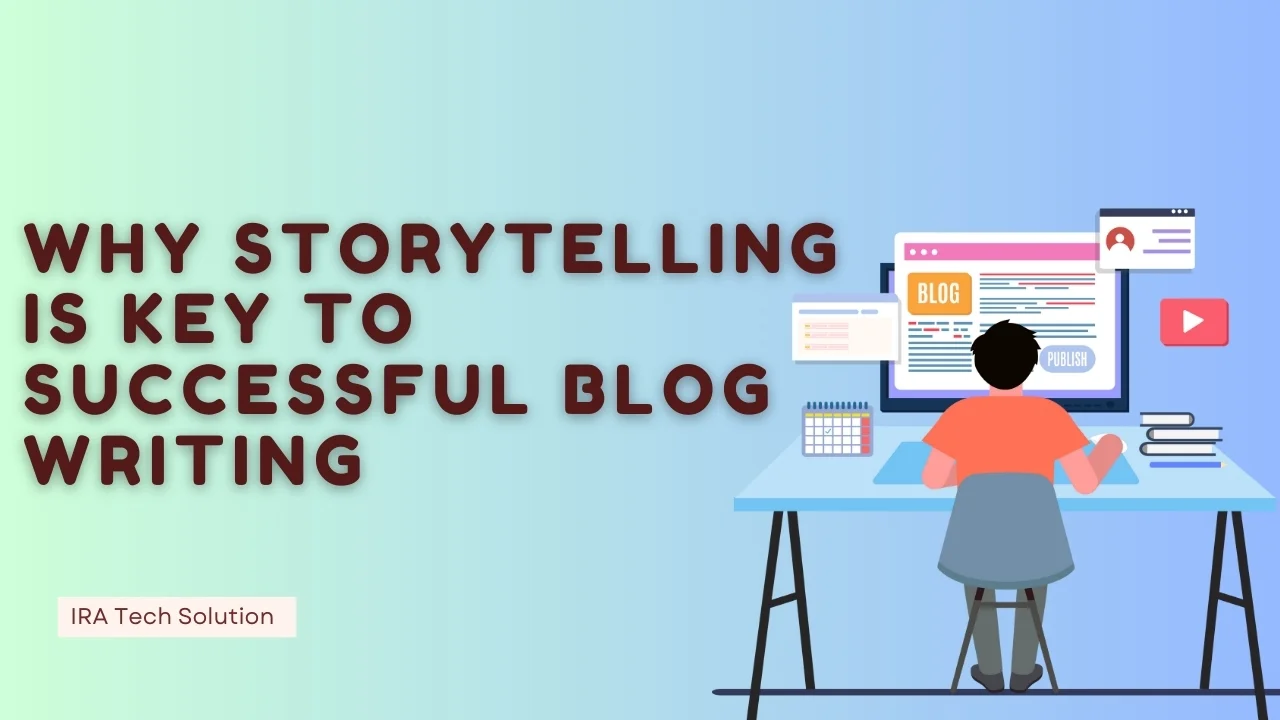
- November 6, 2024
- IRASolutions
- 0
With so many world blogs currently active and more and more people churning out content daily, it has become one of the most efficient ways that many blog writers can employ to win the attention of Internet users.
Apart from being entertaining, stories are memorable so that people can better remember the simplified ideas and the emotion behind them. Whether you’re writing content for your blog, a large company, or even a simple instructional piece, storytelling is key to turning information into an engaging story.
1. Why is storytelling Effective in Blogs?
Building the Emotional Connection with Readers
The most effective blogs are those blogs that interpret the text emotions of readers or viewers. Since opinions are emotional, bloggers can engage readers and make their content relatable and memorable.
This makes it easy for you, the reader, to identify with some of the ideas in the story, feel for the characters, or care about how the plot turns out. This association results in the creation of trust and this kind of dedication that other purely informative or educational blogs may not develop.
For example, instead of writing a formal article discussing the advantages of exercising, you can begin with the real-life experience of how jogging in the mornings changed your life. People can identify with you; thus, your content will be more effective.
Making Complex Topics Easy to Understand
It also incorporates the use of anecdotes as a means of making large chunks of information easily understandable. It is often seen that all blogs are based on technical or Complex issues and stories help make such issues too simple.
So, using facts and data to convey the story will provide readers with enough curiosity and cognition to combine it with more detailed information.
For instance, a blog discussing such a topic as financial planning may turn off some users while presenting it through a story of a young couple starting a life and planning their finances, which makes the reader acquaint themselves with the topic.
2. The Key Elements of Storytelling in Blog Writing
Compelling Characters or Narratives
One of the most important aspects of a story is the characters or the story you want to tell. When speaking about the blog’s characters, they could be you, your readers or viewers, or even the invented ones, which are images of you and your reader or viewer depicted in concrete situations.
People require a character to support, identify with or learn from. These characters also make your text seem based on a more familiar or real-life scenario, making the message more effective.
For instance, in a health blog, you may create a fictional character with a challenge on weight loss; the blog then describes the character’s process as he or she overcomes challenges. This fosters a relationship that occasionally nudges the readers to interact with the online material.
Conflict and Resolution
Conflicts and conflict resolution are always present in great stories. The natural structure of blog writing involves presenting a problem or a challenge and then presenting solutions or ideas, simplifying how readers will be attracted to the content.
Conflict may be as mundane as a typical question; for example, why can the individual not follow through to accomplish what he set out to do? Your conclusion would then be your action plan, which your readers are always interested in knowing.
Using this approach, the blog is given some form of order while, on the same note, viewers become more engaged because they would love to see how the conflict pans out.
Use of Raw Data with Personal Stories
Blogs get tailored with personal experiences or what is referred to as stories within the blog to make blogs warmer and more understanding. It also makes the readers interested in reading, showing that someone is honest and telling from experience.
For instance, if you’re blogging about career development, you might want to use real-life exemplars of success and failure to emphasise your arguments.
3. How to Structure Your Blog as a Story
Crafting a Strong Beginning (Introduction)
To write the introduction part of your blog might be compared to writing the beginning of a story — you should attract attention and get the reader ready for further texts. The introduction aims to capture readers’ attention by presenting a problem, a scene, or a question.
This is where you grab the reader’s attention and present them with something that will make them get past the first paragraph. For instance, something like “I never thought I could live a better life if I woke early; well, a miracle occurred” lets the readers ask for more.
Making Middle (Body) Interesting and Attention-Proving
The largest portion of a blog post as a story is written in the body of the blog post. This is where you give general information, ideas, or solutions to presented problems or give value to the story. Subdivide your content into manageable segments and ensure everyone adds value by keeping the reader engaged.
In a storytelling blog, at the end of the story, you might explain to the reader what your little character (or you) experienced and what he or she/she realised in the process, thus offering them closure.
A storytelling format, including description, imagery, storytelling, and dressed-up real-life situations, should be adopted when delivering lectures. In general, if your blog is about solving a problem, then the body should provide a step-by-step process for solving the problem.
Creating a Memorable Conclusion
A conclusion might be as powerful as a beginning point of the story as it quilts the story. It should give a good solution to a problem or challenge in the dialogue. It is also your last chance to state what your audience wants to remember most and even the last point to give them.
4. Storytelling Techniques for Effective Blog Writing
The Power of Vivid Imagery and Descriptive Language
Descriptive language, together with the use of several speech figures, can greatly enhance the quality of a blog. People can easily picture a scene, leading to the readers being engaged with whatever you are trying to convey. This is what the descriptions should do: make the reader see something and feel it in a way.
For instance, instead of writing, “The park was nice,” describe it in a way that evokes emotion: “The sun was shining through the trees, there was a flicker of golden colours on the green grass, the wind was blowing softly through the trees.”
Incorporating Dialogue and Quotes
Dialogue and quotation bring the real image and activity to a blog. It widens the textual layout when, for example, one character speaks out or when citing an authoritative source. Dialogue helps you explain things instead of generalising, and using quotes from the authorities adds credibility to your content.
For instance, in a travel blog, there might be quick quotes from a citizen to reveal more about the culture, adding depth to the narrative.
Creating Suspense and Curiosity
Another technique found in storying is creating suspense and curiosity. The kind of information that elicits curiosity and a reader’s interest is that which is concealed but slowly disclosed to the reader. To keep engagement, hint at the possible solution to a particular issue or suggest an idea that will be explained in the next blog part.
For instance, if you are writing a blog about productivity tips, you may write something like, “Here is the problem I faced:” And then when you want to highlight the specific method that changed it all, you will write: “But the real solution that worked was this one…”
5. Storytelling to Build Reader Trust and Engagement
Establishing Authenticity Through Storytelling
Trust is all about realistic presentations; therefore, people have to be presented in a believable way, and that is where storytelling comes in handy. The audience is more likely to believe you when they receive the information from the personal account.
Finally, the truth is that people only need a reason to listen to you if you want to share your experiences, bear fruits, and failures with the readers. For instance, a blog post on impostor syndrome will be well appreciated when the writer shares their and other people’s experiences on dealing with impostor syndrome.
Increasing Reader Interaction with Relatable Stories
Promoting interaction are the stories that mirror the experiences of your audience. People more readily respond by commenting, sharing, or even interacting on posts that reflect their own lived reality. When telling the stories, make them as common as possible; you are encouraging people in the community to speak up.
If your blog is about business start-ups, using humour to tell stories of typical mistakes people in business make can make readers comment on their own experiences.
Conclusion: Why Storytelling Should Be Central to Your Blog Strategy
As storytelling effectively hooks the reader’s attention, breaking down the concepts into easily understandable content and ensuring trust lost by competition is regained in blog writing. Whether you are producing how-to articles personal stories, or when covering industry trends, storytelling within your blog-making plan will help you stand out from the competition.
There is nothing as special as using narration in your blog, as it adds a real human aspect that will help catch the attention and provoke nice memories. This article proposes several tips for building on information, such as making an emotional bond with the target audience, using a narrative form to tell vivid stories, and having a proper ‘blog-story’ architecture.
Blogging has become much more than just simple content writing; using storytelling in your blog post is not just a method but a powerful tool for achieving your goals. Incorporate this guide into your content creation strategy; you will inevitably see increased engagement and readership.





